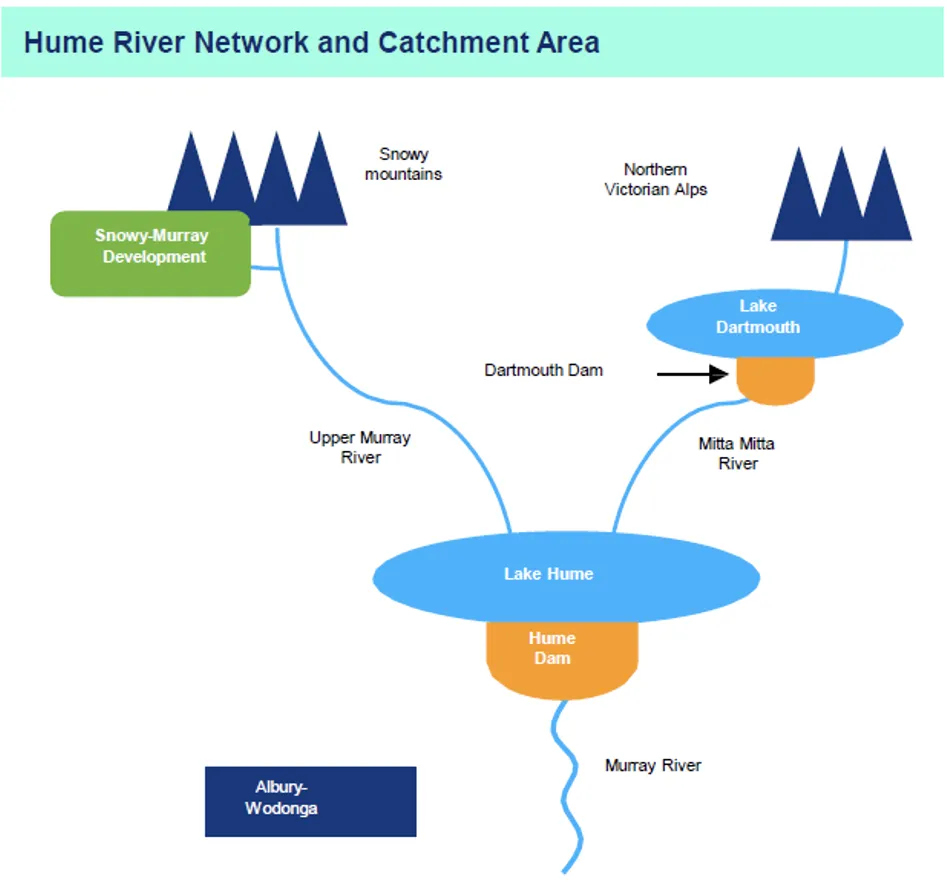Hume Power Station
| Key Data | |
|---|---|
| Dam construction completed | 1936 |
| Hydro power station commissioned | 1957 |
| Dam operating capacity | 3,005 gigalitres |
| Dam height | 42 metres |
| Lake size | square kilometres |
| Generation capacity | 58 megawatts |
| Approximate annual generation | 208.1 gigawatt hours |
Key facts and history
- Hume Power Station is located near the border of NSW and Victoria, close to Albury-Wodonga, and ~300 kilometres downstream from where the Murray rises on the Great Dividing Range
- Maximum water capacity of 3,005 gigalitres, about six times the volume of Sydney Harbour
- The dam has a catchment area of 15,300 square kilometres, two thirds of which is in Victoria
- Flows from the Snowy River may also be diverted into the catchment by the Snowy Mountains Hydro-electric Scheme
- Original purpose of the dam was to provide better water navigation, irrigation and flood and drought control
- Work on Hume Dam started in 1919 and took 17 years to complete
- The Snowy Mountains Scheme resulted in increased flows in the River Murray and, it was agreed to double the previous water storage levels to its current capacity
- Today, Hume Reservoir is the main storage on the River Murray system. It supplies water across three states for irrigated agriculture, environmental flows, town supplies, industry and domestic requirements, flood mitigation and recreation
- Several operational improvements have been made to Hume Dam in more recent years
- A range of structural improvements were made during the 1980s and 1990s in order to meet modern dam safety standards
- In 2010 a further program of improvements began to increase safety in the event of flooding and earthquakes
- Works included an improved filter and drainage system between the concrete spillway and southern embankment, and construction of a 50,000 tonne concrete buttress wall to strengthen the southern training wall
Power Station Overview
- Hume is a concrete gravity dam with earth embankments
- Intake system includes a trash rack, a ‘wheeled’ hydraulically controlled inlet gate and a steel lined penstock which delivers water to the turbines
- Two vertical Kaplan type turbines, rated at 29 megawatt each and capable of running with a maximum static head of 35 metres
- Minimum and maximum flow rates are 800 megalitres per day and 10,500 megalitres per day for each turbine
- The generator units are each rated at 33 megavolt ampere (MVA) at 11 kilovolts (kV). Each unit is connected to the National Electricity Market (NEM) through its step-up generator transformer via overhead conductors to an adjacent switchyard
- Hume is a scheduled market generator in the NEM
- Hume can dispatch output to both the Victorian and New South Wales wholesale electricity markets
- The switchyard is a two bus, double switched breaker arrangement with one 132 kV bus and one 66 kV bus
- The 132 kV transmission line from Hume switching station is connected to the Albury terminal station in NSW
- The 66 kV sub transmission line is connected to the Wodonga terminal station in Victoria
Water supply
- Maximum capacity of 3,005 gigalitres with a depth of 40 metres at a normal elevation of 192 metres Australian Height Datum (AHD)
- Furthest upstream of the major reservoirs on the Murray River and is the river’s main operational storage supply
- Elevations across the catchment area range from 2,200 metres around the eastern alpine peaks to ~150 metres at the Hume Dam
- ~7% of the catchment area is 1,400 metres above sea level and this yields ~18% of the total water makeup of the Hume Dam
- Mitta Mitta river is one of two major Victorian tributaries to the Hume Dam. It flows through the Dartmouth Dam, the largest storage in the Murray system (upstream of the Hume Dam) with a capacity of nearly 4,000 gigalitres
- The Upper Murray River contributes approximately two thirds of annual catchment inflows to the Hume Dam with the remaining third coming from the Mitta Mitta River
- The Hume Dam catchment area is approximately 16,000 square kilometres in size, and makes up 1.5% of the Murray-Darling Basin
- Water releases are managed by WaterNSW to ensure that sufficient water can be supplied to water licence holders. The volume released in the spill phase is based on catchment conditions, likely water demands, inflow and expected future rainfall
- Water is required for irrigation, environmental, town water, industry and flood mitigation purposes
- Inflows at Hume Dam occur over winter and spring (fill phase) with the storage level typically peaking around October
- The dam drains over the irrigation period (August - April) when water demand downstream is high and reaches its lowest storage level around April. As a result, most generation also occurs over the irrigation period

